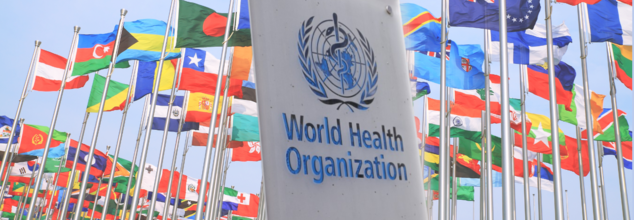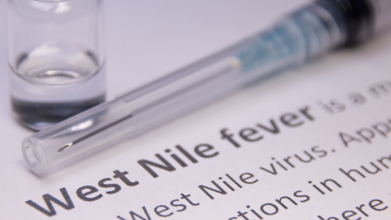- Health Conditions A-Z
- Health & Wellness
- Nutrition
- Fitness
- Health News
- Ayurveda
- Videos
- Medicine A-Z
- Parenting
- Web Stories
WHO Nations Agree To Sign Off On Treaty To Prevent Repeating COVID-19 Failures- 5 Key Facts

Five years since COVID-19 brought the world into a health and economic crisis, the World Health Organization (WHO) has done what many considered unlikely—a global agreement on a draft pandemic treaty. On Wednesday, after years of intricate talks and political upheaval, WHO member states reached a consensus on a historic document that will determine how the world responds to future pandemics. If endorsed at the next World Health Assembly in Geneva, the treaty would have the potential to be a turning point for global public health partnership and readiness.
WHO Director-General Dr. Tedros Adhanom Ghebreyesus greeted the treaty as a badge of unity. "In our polarized world, countries can once again agree and unite for a common response," he said. The pact should bring revolutionary change to how nations prepare and react to health emergencies globally—without repeating the inequities, delays, and fragmented responses that characterized the response to COVID-19.
The global response to COVID-19 revealed systemic weaknesses in international health governance—ranging from vaccine hoarding and disinformation to less-than-generous support for poor countries. These shortcomings prompted WHO member states to create the Intergovernmental Negotiating Body (INB) in December 2021. Their task: to negotiate a strong international instrument centered on prevention, preparedness, and fair response to future pandemics.
Following these were 13 formal sessions, longer-than-usual sessions, and numerous informal discussions. Geopolitical splits and continuous withdrawals from the WHO by such leaders as past U.S. President Donald Trump and Argentina President Javier Milei could not stop the INB finalizing a draft agreement ahead of the official adoption in May 2025.
Key Provisions of the Pandemic Treaty
The suggested agreement has the purpose of establishing a global pandemic response playbook, based on solidarity, equity, and science. Among its most important elements:
Pathogen Access and Benefit Sharing: The treaty requires that nations providing virus samples will enjoy assured access to derived diagnostics, medicines, and vaccines. For its enforcement, WHO will hold up to 20% of such products to guarantee equitable distribution, particularly to low-income countries.
One Health Approach: Acknowledging the interconnectivity of human, animal, and environmental well-being, the treaty promotes cooperation to avoid zoonotic outbreaks and emerging dangers.
Technology Transfer and Capacity Building: The pact ensures transfer of scientific information, manufacturing technology, and capability across countries to develop a geographically dispersed R&D base. This should eliminate geographical concentration of global health innovation and end reliance upon a handful of dominant nations.
Emergency Health Workforce and Supply Chains: States are urged to establish competent health emergency workforce teams and be part of a global supply chain and logistics network for swift response to future health emergencies.
Respect for Sovereignty: Notably, the draft treaty confirms that the WHO will not impose national health legislation or mandates like lockdowns, vaccination orders, or travel restrictions. National sovereignty is preserved, although cooperation is strongly urged.
What are the Controversies and Challenges Surrounding the Treaty?
Though the treaty is a milestone, it is not without controversy. The United States, having been sidelined in Trump's administration pullout from the WHO, is still far from the finalization of the treaty. Though U.S.-based R&D was key to creating effective COVID-19 vaccines and treatments, American officials are not likely to sign the agreement under present provisions.
Likewise, Argentina's recent withdrawal from the WHO is a sign of ongoing distrust among some leaders regarding the role and authority of international health organizations. Opponents claim that international treaties threaten national interests or overreach their limits in governing public health.
The pandemic treaty in draft form is an increasing recognition that no state, no matter how rich or resourceful, can tackle a global pandemic in isolation. It emphasizes the call for transparency, equity, and multilateralism during times of crisis. Adopted at the World Health Assembly in May, the treaty might transform the way the world prepares for and prepares against pandemics—making sure that scientific advancements and essential resources are available to everyone.
As the globe looks back at the tragic losses and bitter lessons of COVID-19, this treaty presents an opportunity to redefine global health in partnership, not rivalry. To future generations, it may signal the start of a more cohesive and resilient global response to common dangers.
Popular Sleep Aid Suspended After Gummies Triggered Kids 'Overdosing' On Melatonin

Credits: Canva
A major online health retailer has suspended sales of melatonin products to Australia after a surge in overdose reports, raising alarm about the widespread and often unregulated use of the hormone as a sleep aid for children.
US-founded iHerb, which delivers supplements and health products to more than 180 countries, abruptly pulled melatonin from its Australian marketplace. The move has left many parents in shock, particularly those who have long relied on the company to sidestep prescription-only rules in Australia.
For years, families have quietly ordered melatonin from overseas to help children with ADHD, autism spectrum disorder, or chronic sleep problems. Many never consulted a doctor, trusting online reviews or anecdotal reassurance instead.
Melatonin Gummies: Parents Divided Between Panic and Relief
For some families, iHerb’s decision feels like a lifeline suddenly cut off. One mother, posting in a support group for parents of neurodivergent children, admitted: “I know a lot of us purchase melatonin from iHerb for our ADHD/ASD kiddos. It’s now been banned due to it being a prescription medicine.”
Another confessed the impact was immediate: “My kids won’t sleep without it.”
But the suspension has also sparked relief among others who fear melatonin has become dangerously normalized. One parent commented, “Honestly, I think this is a good thing. My son is autistic and I use it for him so I understand some children really do need it – but it’s also very overused, and look at all the overdoses from it this year.”
This divide reflects a broader tension in child health: the desperate search for effective solutions versus the risks of self-managing with little medical oversight.
A Surge in Poisonings Raises Red Flags
The catalyst for iHerb’s decision appears to be stark new data out of Western Australia. Calls to the state’s Poisons Information Centre about melatonin overdoses have jumped 166 percent in the past five years, with nearly 90 percent involving children.
In 2018, the hotline logged 175 calls. By August this year, that number had soared to 322.
The majority of cases involve children accidentally consuming too many melatonin gummies. Symptoms reported included stomach pain, dizziness, excessive drowsiness, and headaches. Though rarely fatal, repeated overdoses underscore how the supplement’s candy-like form and lack of dosage regulation put children at risk.
The rise of melatonin gummies has reshaped how parents approach sleep issues. Marketed as natural, gentle aids, they blur the boundary between dietary supplement and pharmaceutical.
Some products even fail to disclose melatonin on their packaging, presenting them instead as magnesium or herbal-based sleep support. Investigations have revealed discrepancies in labeling, with some gummies containing significant levels of melatonin despite being marketed differently.
This grey zone is particularly troubling because, in Australia, melatonin is legally restricted. It is classified as a Schedule 4 prescription-only medicine, available to adults over 55 for short-term insomnia or to travelers for jet lag. For children, it may be prescribed in specific clinical cases, but under strict medical guidance. The online marketplace bypassed all of that until now.
A spokesperson for iHerb told the Daily Mail, “The health and well-being of our customers always comes first. That’s why we are suspending all melatonin sales to Australian customers while we further review our order protocols for these products. Our goal is to support wellness responsibly and to give our customers confidence that they can shop with safety and trust.”
The company has not provided a timeline for when or if sales might resume. Dr. Kyle Hoath of the Australian Medical Association’s Western Australian branch welcomed the suspension. “It’s good to see that iHerb has taken a proactive step,” he said. “The problem is that, when you think about the way an online retailer like iHerb works, there’s no interaction with a pharmacist. It’s the consumer choosing what they want without any guidance around what is safe.”
The move highlights how online platforms can fill regulatory gaps but also create new ones, enabling mass importation of products that would otherwise face strict scrutiny.
While Australia is grappling with the risks of imported melatonin, other countries face similar challenges. In the United States, melatonin is widely available as an over-the-counter supplement, with minimal regulation compared to pharmaceuticals. Usage has skyrocketed among children and teenagers, prompting pediatricians to raise alarms about potential long-term impacts on hormone development and circadian rhythms.
In the UK, melatonin is also tightly controlled, available only by prescription. Yet similar concerns about misleading labeling and accidental overdoses in children have emerged there too. This patchwork of rules creates opportunities for cross-border loopholes—like Australian parents ordering through iHerb that complicate public health responses.
For parents who depended on melatonin, the suspension may feel devastating. But health experts stress that the bigger issue isn’t the lack of access—it’s the lack of medical oversight.
Children’s sleep problems can stem from many causes: neurological conditions, behavioral habits, environmental triggers, or emotional stressors. While melatonin may help in certain cases, it is not a one-size-fits-all solution. Without guidance from a pediatrician, families risk masking deeper issues or creating new ones.
The iHerb suspension is not just a supply chain hiccup it’s a wake-up call about the need for safe, evidence-based care.
How Can Parents Build A Better Bedtime Sleep Routine Without Dependence on Melatonin?
Parents anxious about losing melatonin as an option can take heart: natural, structured approaches to sleep often prove more effective long-term than supplements.
Creating a reliable bedtime routine is one of the most powerful tools. Children thrive on predictability, and a consistent wind-down ritual teaches the brain when it’s time to rest. This can start with dimming lights an hour before bedtime, turning off screens, and engaging in calming activities such as reading together, listening to soft music, or practicing gentle breathing.
Sleep hygiene also extends to the environment. A cool, dark, quiet room signals to the body that it’s time to sleep. White noise machines or soft nightlights can help reduce anxiety, especially for children who struggle with sensory sensitivities.
Parents should pay attention to diet and activity as well. Limiting caffeine and sugar in the afternoon, ensuring children get plenty of daylight exposure and exercise, and timing dinner a few hours before bed can significantly improve sleep readiness.
Perhaps most importantly, bedtime should not feel like a punishment. When framed as a positive, nurturing routine—one that involves connection rather than control children are more likely to settle into it willingly.
While melatonin may play a role for some children under medical supervision, it cannot replace the emotional security and consistency that a healthy routine provides. For families suddenly cut off from supplements, this may be the right moment to reset and rebuild sleep in a sustainable, safe way.
Health Officials Confirm First West Nile Death In Colorado – Can You Get It More Than Once?

(Credit-Canva)
A Fort Collins resident has died from neuroinvasive West Nile virus, as reported by the Larimer County Department of Health and Environment on August 25. This marks the first West Nile virus death in the county this season.
“We are saddened by this loss and extend our deepest condolences to this resident’s loved ones,” said Tom Gonzales, Larimer County's public health director. “This death underscores the potentially serious nature of West Nile virus.”
There have been 20 confirmed cases in the county this season, affecting people from ages 24 to 86. Statewide, there are 69 confirmed cases, with 28 resulting in hospitalization and 28 showing neurological symptoms.
West Nile virus is spread to people through the bite of an infected mosquito. Most people who are bitten by an infected mosquito will have no symptoms or a mild illness, similar to the flu. Less than 1% of people who are infected get a more severe illness that causes inflammation of the brain (encephalitis) or the tissues around the brain (meningitis). Symptoms usually appear within one to two weeks. There is no specific cure for the illness, only supportive care.
West Nile Virus: Why Is There A Sudden Spike in Cases Across US?
Infection rates in mosquitoes in west Fort Collins are 4.5 times higher than normal, according to an August 19 memo to the Fort Collins City Council. The city has sprayed to kill mosquitoes at least seven times this summer because the infection rate in mosquitoes has been high.
The Minnesota Department of Health (MDH) has reported 20 cases of West Nile virus so far in 2025, with two of the infected people having died. The number of cases can change from year to year depending on factors like heat and rainfall. Because of the recent increase, health officials are urging people to be careful.
"This is a high-risk time of year for West Nile virus," said Elizabeth Schiffman, supervisor of MDH's Vectorborne Diseases Unit. "It's important to prevent mosquito bites when people are enjoying time outside while the weather is still nice. That's the best way to avoid getting West Nile virus."
Even with cooler weather and fewer mosquitoes, the virus is still active. Gonzales urges everyone to "take precautions" because "trap data still show that mosquitoes in Larimer County are carrying the virus.”

Is There A Test To Detect West Nile Virus?
According to the Centre of Disease Control and Prevention (CDC) West Nile virus is usually diagnosed by testing blood or spinal fluid for specific antibodies, which are proteins the body makes to fight the virus. These tests look for WNV-specific IgM antibodies, which are a key sign of a recent infection.
In some cases, further testing is needed to confirm the diagnosis. A special test called the plaque-reduction neutralization test (PRNT) can help identify the exact virus causing the infection.
Can West Nile Be Cured?
Most people who get infected with West Nile virus will not show any symptoms. In fact, about 80% of people won't feel sick at all.
Also Read: Israeli Scientists Created The First Lab-Grown Kidney That Survived 34 Weeks
For those who do get sick, symptoms usually appear 2 to 14 days after being bitten by an infected mosquito. Symptoms can take longer to appear in people with a weakened immune system.
There is no specific treatment for West Nile virus. For a mild illness, managing symptoms at home with over-the-counter medicine and rest is often enough. For a severe illness, patients are usually hospitalized for supportive care, such as IV fluids and pain medication.
Can You Get West Nile More Than Once?
According to South Dakota Department of Health, healthcare professional believe that it is possible to get West Nile virus more than once, but it is highly unlikely.
After a person is infected with West Nile virus, the body develops immunity to the specific strain of the virus that caused the infection. This immunity is generally believed to be long-lasting, providing protection against future infections from the same strain.
However, there are different strains of West Nile virus, and it's theoretically possible to be infected with a different strain. Additionally, a person's immune response can vary, and some people may have a weaker or less lasting immunity than others. For example, people with weakened immune systems may not develop strong, long-lasting immunity after their first infection.
While re-infection is a possibility, the risk is extremely low. Most people who have had West Nile virus are considered to be protected from future infections. The most important prevention measure is to continue protecting yourself from mosquito bites.
TV Anchor Dermot Murnaghan Shares Health Update On Stage 4 Cancer Battle, Urges Men To Get Tested Sooner

Credits: Skynews Media
When veteran broadcaster Dermot Murnaghan revealed he had been diagnosed with stage 4 prostate cancer, the news came as a shock to viewers who had long trusted him to deliver the headlines. Now, at 67, the former Sky News anchor is speaking candidly about his health battle—and his urgent plea is resonating far beyond the UK. His story is not just about one man’s fight with cancer; it highlights the larger problem of underdiagnosis and the lack of routine prostate screening programs, even in advanced health systems.
Murnaghan describes his diagnosis as a “bolt from the blue.” While on holiday, he suddenly fell ill and returned home for urgent treatment. What followed was a devastating revelation: advanced prostate cancer that had already spread. What makes his story even more striking is that he had not experienced the common warning signs.
Also Read: FDA Approves New COVID-19 Vaccines In US With Restricted Access, Check Eligibility And Other Rules
Typical prostate cancer symptoms can include difficulty urinating, blood in urine, erectile dysfunction, or persistent lower back pain. Murnaghan, however, showed none of these red flags. His experience underscores what health experts have warned for years—prostate cancer can develop silently, only revealing itself when it has already reached advanced stages.
Since his diagnosis, Murnaghan has undergone chemotherapy, completing his rounds earlier this summer. He describes the treatment as both grueling and strangely reassuring. “It’s hard, but you feel you are actively doing something, in the hands of wonderful medical professionals,” he told Sky News. Yet, once chemotherapy ended, he admitted to a psychological gap. “Now it’s the waiting-and-seeing phase. We’re just hoping to see how much has been achieved.”
This waiting game is one familiar to many cancer patients. The treatment may stop, but the uncertainty lingers. Still, Murnaghan says he is “feeling pretty good,” a sign of cautious optimism as he continues monitoring his progress with doctors.
What Is Dermot Murnaghan’s Plea For Men?
If there’s one message Murnaghan is determined to share, it’s this: men cannot afford to be passive about their health. In his candid interviews, he admitted to delaying screening, despite years of reporting on health issues as a journalist. “I foolishly sat in that chair for many years, telling men over 50 to get tested. And when it came to myself, I kept putting it off. Life gets in the way—work, family, holidays. But cancer doesn’t wait.”
The broadcaster urges men, particularly those over 50 or with a family history of prostate cancer, to be proactive. “Go and demand it,” he insists, stressing that in the UK and many other countries, prostate testing is not automatically offered. Unlike breast cancer or bowel cancer, where routine screenings are built into public health systems, prostate cancer relies heavily on individual initiative.
Can PSA Testing Save Lives?
At the center of the discussion is the prostate-specific antigen (PSA) test. This blood test measures the levels of a protein produced by the prostate. High PSA levels may indicate prostate cancer, though not always—it can also signal other prostate conditions.
Critics argue that PSA testing risks over-diagnosis, identifying cancers that may never cause harm. But Murnaghan and many advocates believe the benefits outweigh the risks, especially when weighed against the devastating impact of late-stage cancer. “They might cost more money, but think about the money you save in the long run,” he argued. His call echoes ongoing debates in medical communities worldwide, where the lack of consensus on prostate screening continues to leave many men vulnerable.
Murnaghan’s case also shines a light on broader health system shortcomings. Cancer Research UK acknowledges that there is no reliable national screening program for prostate cancer. As a result, thousands of men “fall through the gaps,” much like Murnaghan himself did.
This concern is echoed by One Cancer Voice, a coalition of more than 60 cancer charities. The group is pressuring the UK government to prioritize earlier diagnosis and prevention strategies. Their message is clear: without structured screening programs, too many cancers will continue to be caught at advanced stages, where treatment is more invasive, costly, and often less effective.
Despite his ongoing treatment, Murnaghan is not stepping away from the spotlight. He continues to host shows, including the true crime documentary series Killer Britain and the Legends of News podcast. This September, he will also take part in Sir Chris Hoy’s fundraising bike ride, Tour De 4, to raise money for cancer charities. “It’s a wonderful idea. Hats off to Chris Hoy,” he said, acknowledging the Olympian’s own terminal cancer diagnosis announced in 2024.
By combining his professional voice with personal advocacy, Murnaghan is leveraging his platform to turn a private struggle into public awareness. For many men, hearing a respected journalist speak openly about cancer testing may be the push they need to take action.
What Men Need to Know About Prostate Cancer?
Globally, prostate cancer remains one of the most common cancers among men. According to the American Cancer Society, about 1 in 8 men in the United States will be diagnosed during their lifetime. While survival rates are high when the disease is caught early, advanced cases are much harder to treat.
Risk factors include age (most cases occur in men over 50), family history, race (African-American men are at higher risk), and lifestyle factors such as obesity. The challenge, however, lies in the disease’s ability to develop quietly. That’s why advocates stress the importance of early screening—even in the absence of symptoms.
Also Read: Measles Alert Issued In Brisbane After Traveller Returning From Bali Tests Positive
Murnaghan’s message is resonating far beyond the UK. In the United States and other countries, similar debates about prostate cancer screening are ongoing. Should routine PSA testing be offered as part of regular health check-ups? Or should men continue to rely on requesting it themselves?
What his story makes clear is that waiting for symptoms is a gamble. For men who want to safeguard their health, the safer path is proactive testing and conversations with their doctors.
© 2024 Bennett, Coleman & Company Limited

